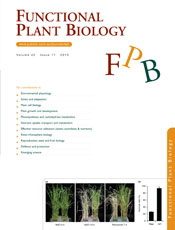
Functional Plant Biology
Volume 42 Number 11 2015
FP15151Lipoxygenase 2 functions in exogenous nitric oxide-induced stomatal closure in Arabidopsis thaliana
The stomata controls water and gaseous exchange and even the response to bacterial invasion. Its aperture is finely regulated by plants. However, its regulation mechanism still needs to be explored. The possible role of oxylipin in NO signalling in guard cells was studied and the existence of LOX-NO crosstalk in A. thaliana guard cells was indicated.
FP15126Physiological characterisation and fine mapping of a salt-tolerant mutant in rice (Oryza sativa)
Salt-tolerant mutants are valuable resources for basic and applied research on plant salt tolerance. In the present study, we characterised a salt-tolerant rice mutant that had a higher survival rate under salt stress and found that its increased tolerance to salt stress was controlled by a single gene located on Chromosome 6. This result will be useful for molecular breeding to improve the salt tolerance of rice.
FP15140Modelling photosynthesis in flag leaves of winter wheat (Triticum aestivum) considering the variation in photosynthesis parameters during development
Modelling photosynthesis is one key step in estimating plant biomass under different growth conditions. In this study, we investigated and quantified the patterns of the photosynthesis parameters Vcmax, Jmax and gm during flag leaf development in two cultivars of winter wheat. The dynamics of the photosynthesis parameters, particularly gm, play an important role in estimating the photosynthesis rate of winter wheat, which greatly improves the modelling of photosynthesis in plants.
FP15003Responses of pea plants to elevated UV-B radiation at varying nutrient levels: N-metabolism, carbohydrate pool, total phenolics and yield
A holistic study to evaluate elevated UV-B response of a legume at varying NPK additions was not attempted before. In the present study, various metabolic- and oxidative stress related variables of pea were analysed and correlated with nitrogen (N) metabolism and plant performance. Recommended NPK through optimum N metabolism helped the plants to counter the negative impact of elevated UV-B, maximally by maintaining yield.
FP15172Copper amine oxidase-catalysed hydrogen peroxide involves production of nitric oxide in darkness-induced stomatal closure in broad bean
As the commonest environmental factor, the light–dark cycle regulates transpiration and gas exchange in plants by controlling stomatal movement. This work shows that the copper amine oxidase-catalysed product H2O2 is required for NO production and cytosolic alkalinisation in darkness-induced stomatal closure. This finding may contribute to the knowledge of the guard-cell signalling cascade in response to darkness.
FP15190In vitro cell wall extensibility controls age-related changes in the growth rate of etiolated Arabidopsis hypocotyls
Cell wall extensibility is a crucial characteristic controlling plant cell growth at the biophysical level that is currently estimated by various indirect methods. We have developed new metrics providing very accurate cell wall extensibility assessment and offered novel statistical approaches for their comparisons. Our findings will help discover new proteins that regulate plant cell growth by influencing cell wall extensibility.
FP15080Expression of maize heat shock transcription factor gene ZmHsf06 enhances the thermotolerance and drought-stress tolerance of transgenic Arabidopsis
Heat shock factors (HSFs) play an important role in regulation of heat-induced transcriptional reprogramming. To understand the molecular mechanism of maize adaptation to heat stress, the ZmHsf06, A1 subclass, was cloned and the expression and role were investigated. ZmHsf06 may be a central representative of maize Hsfs and useful as a candidate gene in molecular breeding of crops for enhanced tolerance during terminal heat and drought stresses.
FP15079A comparative structural and functional study of leaf traits and sap flow in Dracaena cinnabari and Dracaena draco seedlings
Trait-based approaches have become widely used in ecophysiology as a proxy of community responses to environmental changes. This study documents the differences in sap flow and water-related leaf traits in seedlings of two remote Dracaena species: Dracaena cinnabari and Dracaena draco. Our results provide an important context for research into the function of water transport in arborescent monocots and may help to predict the potential direction of plant evolution in response to possible future global warming and changing land use.




